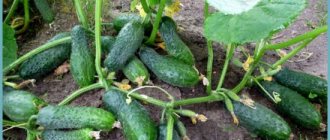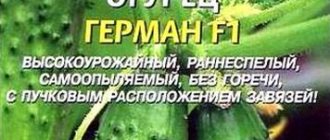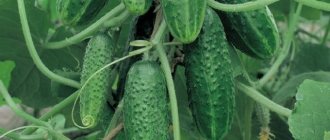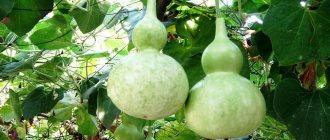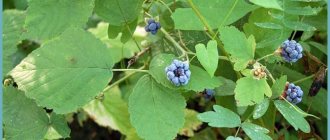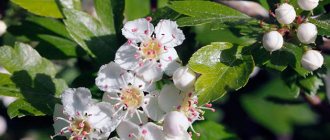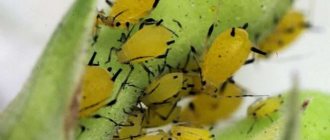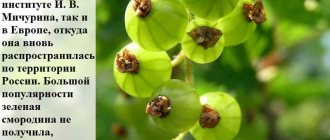One day, a friend who came to visit us from the Crimea gave me a light green pear-shaped fruit with an unusual name - chayote.
After a short conversation with Google, it turned out that growing the Mexican chayote cucumber in northern latitudes is only possible in greenhouses. This somewhat cooled my interest in this culture.
Nevertheless, I still decided to share with you detailed agricultural technology of chayote, so that summer residents living in warm regions can experience the exotic on their site.
Botanical description
Chayote is a climbing monoecious plant with slightly pubescent shoots with longitudinal grooves that cling to support with the help of tendrils. Rhizomes reach 20 m in length, form tubers weighing up to 10 kg. The texture of the pulp resembles a cucumber. The color of the tubers varies from light green or yellow to dark green. The flowers are unisexual, corolla diameter is 1 cm. The leaves are broadly rounded, covered with stiff hairs, and have a heart-shaped base with blunt lobes.
The fruits are round or pear-shaped berries, with one flat-oval seed (3-5 cm in length), weighing up to a kilogram. Their skin is thin, covered with longitudinal grooves, durable and shiny, light yellow, green or whitish in color. The pulp is rich in starch, juicy, sweet, light green in color.
Benefits and harms
Mexican cucumber leaves have a diuretic effect and are used to treat urolithiasis, hypertension and eliminate swelling. Tubers have anti-inflammatory properties and are used to combat atherosclerosis. The fruits of the plant help get rid of constipation, hemorrhoids, and improve the condition of the thyroid and pancreas.
Chayote is a source of essential amino acids and fiber. Lysine, which is part of the Mexican cucumber, limits the value of plant proteins, is involved in the production of antibodies, hormones, enzymes, the processes of restoration of collagen fibers, reduces the likelihood of herpes and normalizes cholesterol, and controls nitrogen balance. According to the conclusion of American nutritionists, chayote is a low-calorie product that normalizes metabolism, which can be used to solve problems with excess weight and cellulite.
Decoctions of Mexican cucumber are indicated for use by cancer patients after a course of chemotherapy, men with adenoma and prostatitis, women with mastopathy, fibroids, fibroids, uterine or breast cancer. In addition, the fruits have diaphoretic properties and are used as a source of ascorbic acid to increase the body's barrier functions and prevent colds.
The only contraindication to using the product is individual intolerance.
May support liver function
Fatty liver disease is a disease in which excess fat is deposited in the liver tissue. Too much fat in your liver can affect its ability to function properly ().
Both test-tube and animal studies suggest that Mexican cucumber chayote extract may protect against fat accumulation in the liver, thereby potentially preventing or reversing fatty liver disease (, ).
In one study, high-fat diet-fed rats that received chayote extract had significantly lower liver cholesterol and fatty acid levels than control rats. This was associated with apparent changes in the function of enzymes involved in fat metabolism ().
At this time, more research is needed to understand how chayote may support liver health in humans.
Summary:
Test-tube and animal studies suggest that chayote extract may reduce the accumulation of fat in your liver, potentially protecting against fatty liver disease. However, more research is needed.
Chemical composition
Chayote cucumber is a low-calorie product (19 kcal per 100g), in which all parts of the plant are suitable for consumption except the stem. The composition of the vegetable is dominated by carbohydrates (4.5 g), fiber (1.7 g), mono- and disaccharides (1.66 g), while containing little protein (0.8 g) and fat (0.1 g) .
Just like a regular cucumber, the Mexican representative of the pumpkin family contains 94.24 g of water, which makes it a desirable product for weight loss.
Table No. 1 “Chemical composition of chayote”
| Name | Content per 100 g of raw material, milligram |
| Vitamins | |
| Choline (B4) | 9,2 |
| Ascorbic acid (C) | 7,7 |
| Niacin (B3) | 0,47 |
| Pantothenic acid (B5) | 0,249 |
| Alpha tocopherol (E) | 0,12 |
| Folic acid (B9) | 0,093 |
| Pyridoxine (B6) | 0,076 |
| Riboflavin (B2) | 0,029 |
| Thiamine (B1) | 0,025 |
| Phylloquinone (K) | 0,0041 |
| Macronutrients | |
| Potassium | 125 |
| Phosphorus | 18 |
| Calcium | 17 |
| Magnesium | 12 |
| Sodium | 2 |
| Microelements | |
| Zinc | 0,74 |
| Iron | 0,34 |
| Manganese | 0,189 |
| Copper | 0,123 |
| Selenium | 0,0002 |
Table No. 2 “Amino acid composition of chayote”
| Name | Concentration of substance in 100 g of product, grams |
| Glutamic acid | 0,125 |
| Aspartic acid | 0,092 |
| Leucine | 0,077 |
| Valin | 0,063 |
| Alanin | 0,051 |
| Phenylalanine | 0,047 |
| Serin | 0,047 |
| Proline | 0,044 |
| Isoleucine | 0,044 |
| Glycine | 0,041 |
| Threonine | 0,04 |
| Lysine | 0,039 |
| Arginine | 0,035 |
| Tyrosine | 0,032 |
| Histidine | 0,015 |
| Tryptophan | 0,011 |
| Methionine | 0,001 |
At home, chayote fruits are stored in a paper bag in the vegetable compartment of the refrigerator for no more than 3 weeks, and leaves for 5 days.
History of the Mexican cucumber
Unlike other crops, there is no archaeological evidence for how long chayote has been cultivated. Its fleshy fruits along with seeds do not last long. As far as is known, no pollen grains or other structure of this species have been found at archaeological sites.
Chayote is found wild in the cool mountains of Central America. It is believed that it was here that it was first domesticated by the Aztecs.
Southern Mexico and Guatemala are the centers of the greatest variety of cultivated chayote vegetables. They are probably also the center of origin of this ancient culture.
Today, the plant is grown throughout the tropical highlands, as well as in subtropical regions of the world for the edible use of vegetables and tubers.
Prickly chayote (Sechium edule) was originally domesticated in Mexico and seen in South America before the Spanish conquest. The Mexican cucumber was a staple food for the Aztecs.
The name comes from Nahuatl chayotli. The vegetable is actually a member of the Cucurbitaceae family, which is very unusual considering it has a single seed and is a perennial plant.
The Mayans added chayote shoots as greens to beans and also ate the fruits and starchy roots.
Use in cooking
Mexican cucumber can be stewed, baked, stuffed, pickled, salted, fried, boiled. Tubers, leaves, and fruits of the vegetable are used to prepare side dishes, sauces, salads, and puree soups.
Boiled young shoots in salted water taste like asparagus. Green leaves are consumed raw or stewed and served as a side dish for meat and fish dishes. Chayote tubers are a source of starch (up to 25%), they are dried and ground into flour or fried. The unripe fruits of the plant are combined with vegetables (eggplant, onions, mushrooms, tomatoes, zucchini), vegetable oil and hot spices (cayenne pepper, Tabasco), which highlight the neutral taste of the cucumber.
Cooking recipes:
- Salad "Freshness". Ingredients: chayote (leaves and fruit), dill, parsley, boiled egg, garlic. Chop all salad components and season with low-fat sour cream.
- Stuffed cucumber. Ingredients: chayote fruit, onion, carrots, minced meat. Cut the cucumber in half and remove the pulp. Sauté onions and carrots and mix with minced meat. Fill the vegetable halves with the resulting filling and bake in the oven for 30 minutes at 180 degrees.
- Cream soup. Ingredients: onion, chayote, cream, salt, pepper. Cut the vegetable into slices and boil for 5 minutes. Fry the onion in vegetable oil. Mix all ingredients and puree in a blender until smooth. Serve hot.
Fruits give chayote its original taste. The fruits of the Mexican cucumber are used together with apples and cinnamon to fill pies. In this combination they acquire a sweet taste.
It is recommended to give preference to medium-sized, green fruits. The flesh of a Mexican cucumber should be firm to the touch, without dents, scratches or damage.
Before cooking, the vegetable is washed, and large representatives of the species are peeled. For safety reasons, the skin of the vegetable should be cut using protective gloves, since the liquid released on its surface can cause skin irritation. After this, the fruit is washed again under running water.
May slow down visible signs of aging
One of the main theories of aging is based on molecules called free radicals, which cause damage to your cells, ultimately leading to decreased functionality over time (14).
Some research suggests that consuming foods high in antioxidants may slow the aging process by protecting cells from free radical damage (14).
Chayote is rich in antioxidants, one of which is vitamin C.
In addition to its antioxidant capacity, vitamin C is essential for the production of collagen, one of the main proteins found in your skin. Collagen gives skin firmness and youthfulness (15).
Thus, adequate consumption of vitamin C-rich foods such as chayote may help reduce visible signs of aging (15).
Moreover, a recent test-tube study showed a strong protective effect of chayote extract on human skin cells against damage associated with ultraviolet radiation (16).
Ultimately, further research is needed into the effects of chayote on skin health.
Summary:
Chayote contains several antioxidants, including vitamin C, which may promote youthful skin and reduce visible signs of aging.
Growing and Harvesting
Mexican chayote is a light- and moisture-loving plant that loves warmth and nutritious soil. Only in such conditions (tropics) is the vegetable grown as a perennial crop. In countries with cool climates it grows as a yearling. Propagated vegetatively - by stem cuttings or seeds. The fruits ripen 90-150 days after sowing (depending on the variety).
A distinctive feature of the plant is its high yield. From one 4-year-old bush, up to 80 fruits are harvested per season.
The growing season of the crop lasts 200 days. Before planting, the soil is dug up and filled with mineral (100 g of potassium salt and 50 g of superphosphate per 1 sq. m.) and organic (6 kg of compost per 1 sq. m.) fertilizers. First of all, chayote forms a ribbed stem with lateral shoots-lianas and massive internodes in which tendrils and flowers are formed. Initially they are soft and straight, but over time they become coarser, curling in a ring. In the first year the stem is flexible and grassy, then gradually becomes woody.
The plant has a powerful root system. Underground tubers are formed on the shoots, weighing 200 g each, like potatoes. Interestingly, in countries with a subtropical climate, the mass of the fleshy root can reach 9 kg.
In the case of chayote propagation by seed, the entire ripe fruit is planted in the ground. Interestingly, the nucleus grows inside it. The fruit is oriented at 45 degrees to the surface of the earth, wide side down, covered 2/3 with soil. First, roots form, after which a young shoot breaks through the fruit and a period of intensive growth begins, which lasts 14 days. At this time, it stretches upward and forms shoots. The fruit provides a supply of nutrients to the plant. 2 weeks after planting the seed in the ground, strong shoots (2-3 pieces) are left on the sprouts, and the rest are removed. And after 170 days the first harvest is collected.
Interestingly, chayote seeds are buried in the soil at an ambient temperature of +27 degrees, since the plant does not tolerate cold and frost. Lowering the temperature to 0 degrees not only slows down the development of the crop, but has a detrimental effect on shoots, leaves and seedlings. At minus 3 degrees, it drops its fruits and the roots begin to die.
To grow Mexican cucumbers, choose soil with a maximum freezing depth of no more than 3 cm.
In the case of vegetative propagation, cuttings 15 cm long are formed from young shoots, which are planted in soil consisting of a layer of peat (7 cm) and river sand (10 cm). To increase the germination of the plant, it is covered with a film and high air humidity is provided. At the same time, it is important to ensure that the soil temperature does not drop below +15 degrees, otherwise crop growth will freeze. Chayote is planted in mid-May.
Best materials of the month
- Coronaviruses: SARS-CoV-2 (COVID-19)
- Antibiotics for the prevention and treatment of COVID-19: how effective are they?
- The most common "office" diseases
- Does vodka kill coronavirus?
- How to stay alive on our roads?
Caring for a Mexican cucumber comes down to regular watering, loosening, weeding and fertilizing the area, tying the shoots to a trellis or stakes. The harvest is carried out as it ripens; the fruits are stored in a dry, dark room at a temperature of +5 degrees.
During the dry period, to prevent the ovaries and flowers from falling off, the crop is watered with warm water, otherwise root rot will develop.
May have anti-cancer properties
Higher consumption of fruits and vegetables is associated with a reduced risk of various types of cancer, including gastrointestinal cancer (11).
Test-tube studies show that certain chayote compounds may slow the growth and progression of some cancer cells, such as cervical cancer and leukemia (12, 13).
Although these results are promising, current evidence is not strong enough to understand whether chayote has an anti-cancer effect in humans.
Ultimately, more research is needed.
Summary:
Some test-tube studies suggest that compounds in chayote may have anti-cancer effects, but more research is needed.
Conclusion
Chayote is a perennial plant with edible fruits that does not tolerate frost. It is a powerful vine reaching 12 m in height. Chayote is a low-calorie product, containing only 19 kcal per 100 g. The texture of the fruit pulp resembles a potato; it contains 25% starch, 17 amino acids, dietary fiber, sugars and a set of vitamins and mineral compounds. All parts of the plant are edible except for the woody stem. Mexican cucumber leaves are used in folk medicine to relieve swelling, lower blood pressure and treat urolithiasis. Young roots and fruits are widely used in cooking for preparing side dishes, salads, and puree soups. The stem is used for weaving straw things, and the old shoots are used for livestock feed.
Currently, the culture is not widespread, but due to its rich chemical composition and beneficial properties, it is expected that the plant will become widely popular in the near future.
More fresh and relevant information about health on our Telegram channel. Subscribe: https://t.me/foodandhealthru
We will be grateful if you use the buttons:
May promote healthy weight
Mexican chayote cucumber contains very few calories but is high in fiber, which may help maintain optimal body weight ().
A whole chayote (200 grams) provides 39 calories and 4 grams of fiber. Fiber slows the rate at which your stomach empties, making you feel fuller longer, which can reduce your food intake and promote weight loss (, ,).
Moreover, research shows that consuming fiber may increase levels of satiety hormones such as GLP-1 and peptide YY ().
Thus, including chayote in your diet can help you keep pace with your weight loss goals.
Summary:
Chayote is low in calories and high in fiber, which can help you lose weight and maintain a healthy weight.

